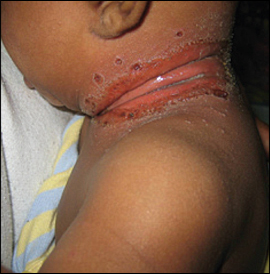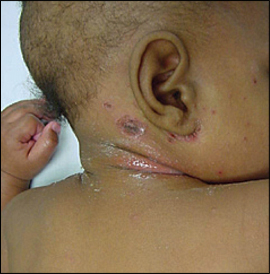
Am Fam Physician. 2008;77(7):1015-1016
Author disclosure: Nothing to disclose.
A five-month-old boy presented with rashes on his neck, groin, and shoulders that had persisted for three days. The rashes began as slightly red skin and progressed to brighter red, peeling skin. The child's birth was a term, uncomplicated vaginal delivery. His mother had no history of sexually transmitted or group B streptococcus infections. She breastfed and did not send the child to day care. The mother denied that the child had prolonged sun exposure or contact with sick persons or new lotions, creams, detergents, jewelry, or pets.


Question
Discussion
The answer is B: candidal intertrigo. Intertrigo is a superficial dermatitis occurring on skin surfaces that commonly come in contact with other skin surfaces, such as the axillae, neck creases, intergluteal folds, and web spaces between the toes and fingers. The condition is primarily characterized by mild erythema on each side of the skinfold in a mirror-image pattern.1, 2
Treatment of simple intertrigo includes minimizing moisture and reducing friction. Secondary bacterial and fungal infections should be treated with topical or oral antibiotics or antifungals, depending on the extent, severity, and likely pathogen. Lesions usually heal without scarring. If these therapies fail, bacterial cultures and testing for sensitivities should be performed. There is little evidence to support a specific preventive measure for intertrigo; therefore, efforts should focus on eliminating causative factors (e.g., applying an absorptive powder, such as cornstarch or a barrier cream, to affected skin surfaces).1
Acrodermatitis enteropathica is a rare disorder of zinc metabolism that can be congenital or acquired. The congenital form is characterized by an inability to absorb zinc from the intestine. Subsequent zinc deficiency typically leads to a well-demarcated, erythematous, scaly dermatitis around the mouth or anus; diarrhea; and nail dystrophy. The rash spreads to the face, scalp, hands, feet, skin flexures, and trunk. In the acute phase, atrophy of the brain cortex leads to irritability and emotional disturbances. Supplemental zinc usually eliminates the symptoms.3,4
Contact dermatitis is an inflammatory skin response to contact with an antigen or irritant. Clinical findings range from a mild, itchy rash to severe pruritus, edema, and blistering. Blistering lesions can break, become exudative, and weep clear fluid. In severe cases, open sores may become secondarily infected. Diagnosis is primarily based on clinical appearance and history of exposure to an irritant or allergen.5
Seborrheic dermatitis is a form of skin inflammation that causes a red, oily, flaking skin rash in areas rich with sebaceous glands. Clinical findings include dry or greasy scales on the scalp (cradle cap) or a yellow or red scaly rash along the hairline, behind the ears, in the ear canal, on the eyebrows, around the nose, or on the chest.
Staphylococcal scalded skin syndrome appears as tissue paper–like skin wrinkling followed by the appearance of large fluid-filled blisters on the axillae, on the groin, and in body orifices such as the nose and ears. The rash may spread to the arms, legs, and trunk. In newborns, lesions are often found in the diaper area or around the umbilical cord.6
| Condition | Characteristics |
|---|---|
| Acrodermatitis enteropathica | Dry, scaly, erythematous patches and plaques on the face, scalp, hands, feet, skin flexures, or trunk |
| Candidal intertrigo | Red, macerated rashes involving skinfolds with surrounding scaling; satellite lesions are common |
| Contact dermatitis | Pruritic, erythematous skin with occasional edema and blistering confined to the area of contact with an irritant; scaling, skin fissuring, and lichenification are possible |
| Seborrheic dermatitis | Erythematous, scaling, flaking, nonpruritic rashes around the hairline or on the scalp, behind the ears, in the ear canal, on the eyebrows, around the nose, or on the chest |
| Staphylococcal scalded skin syndrome | Tissue paper–like skin wrinkling followed by the appearance of bullae in intertriginous regions and body orifices; peeling of the top skin layer leaving a moist, red, tender area |